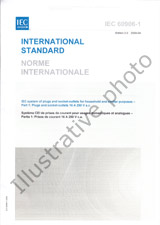We need your consent to use the individual data so that you can see information about your interests, among other things. Click "OK" to give your consent.

IEC 60060-2-ed.3.0
High-voltage test techniques - Part 2: Measuring systems
STANDARD published on 29.11.2010
The information about the standard:
Designation standards: IEC 60060-2-ed.3.0
Publication date standards: 29.11.2010
SKU: NS-408423
The number of pages: 149
Approximate weight : 478 g (1.05 lbs)
Country: International technical standard
Category: Technical standards IEC
The category - similar standards:
Measurement of electrical and magnetic quantitiesElectrical and electronic testing
Annotation of standard text IEC 60060-2-ed.3.0 :
IEC 60060-2:2010 is applicable to complete measuring systems, and to their components, used for the measurement of high voltages during laboratory and factory tests with direct voltage, alternating voltage and lightning and switching impulse voltages as specified in IEC 60060-1. For measurements during on-site tests see IEC 60060-3. The limits on uncertainties of measurements stated in this standard apply to test levels stated in IEC 60071-1:2006. The principles of this standard apply also to higher levels but the uncertainty may be greater. This standard also defines the terms used, methods to estimate the uncertainties of high-voltage measurements, states the requirements which the measuring systems shall meet, describes the methods for approving a measuring system and checking its components and describes the procedures by which the user shall show that a measuring system meets the requirements of this standard, including the limits set for the uncertainty of measurement. This third edition cancels and replaces the second edition, published in 1994, and constitutes a technical revision. The significant technical changes with respect to the previous edition are as follows: - The general layout and text was updated and improved to make the standard easier to use. - The standard was revised to align it with IEC 60060-1. - The treatment of measurement uncertainty estimation has been expanded. La CEI 60060-2:2010 est applicable aux systemes de mesure complets et a leurs constituants lorsquils sont utilises pour la mesure de hautes tensions realisee lors dessais en laboratoire et en usine en tension continue, tension alternative, tensions de chocs de foudre et de manoeuvre tels quils sont definis dans la CEI 60060-1. Pour les mesures realisees lors dessais in situ, voir la CEI 60060-3. Les domaines dincertitudes de mesure dont il est fait etat dans la presente norme sappliquent aux niveaux dessais definis dans la CEI 60071-1:2006. Les principes developpes dans la presente norme sappliquent aussi a des niveaux de tension dessais plus eleves, mais lincertitude peut en etre alors plus elevee. La presente norme definit les termes utilises, decrit des methodes pour estimer les incertitudes des mesures des hautes tensions, determine les exigences auxquelles doivent satisfaire les systemes de mesure, decrit les methodes a utiliser pour qualifier un systeme de mesure et pour en controler les differents constituants, et decrit la procedure par laquelle lutilisateur doit montrer quun systeme de mesure satisfait aux exigences de la presente norme, y compris le domaine fixe pour lincertitude de mesure. Par rapport a ledition precedente, les modifications techniques majeures sont les suivantes: - La disposition generale et le texte ont ete mis a jour et ameliores pour rendre la norme plus facile a utiliser. - La norme a ete revisee afin de laligner sur la CEI 60060-1. - Le traitement de lestimation de lincertitude de mesure a ete elargi.
We recommend:
Updating of laws
Do you want to be sure about the validity of used regulations?
We offer you a solution so that you could use valid and updated legislative regulations.
Would you like to get more information? Look at this page.



 Cookies
Cookies
